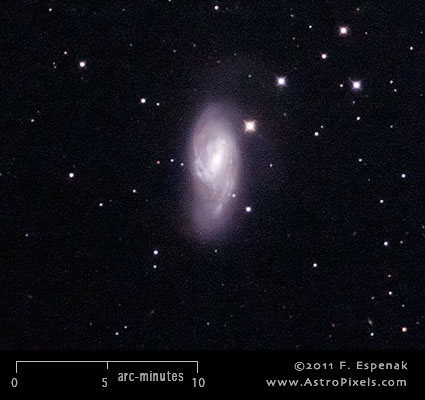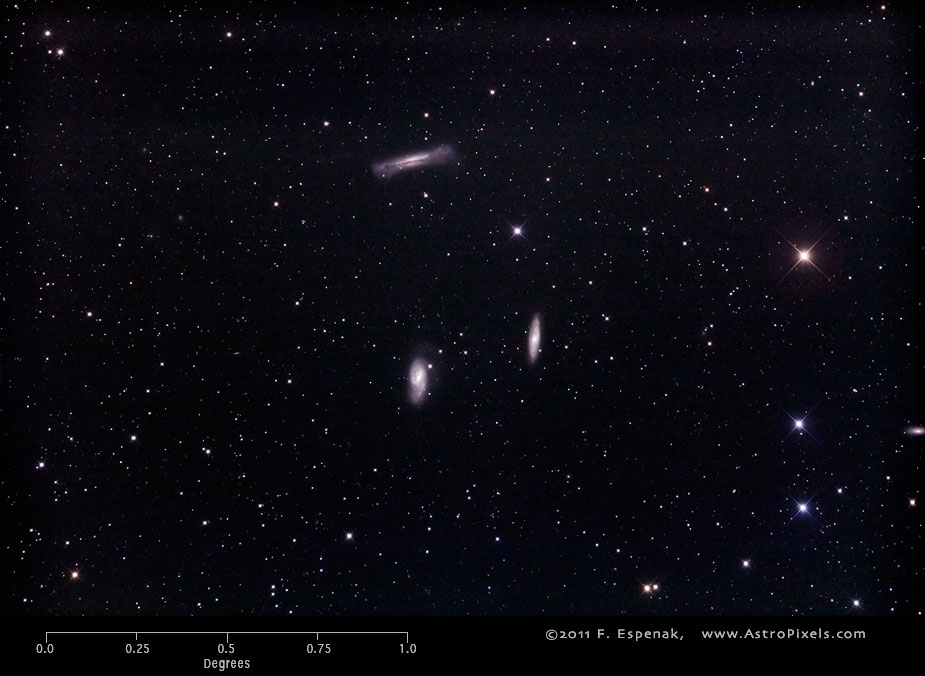
M66
Messier 66 or M66 (also designated NGC 3627) is a spiral galaxy in the constellation Leo. It has an apparent visual magnitude of 8.9 and its angular diameter is 8x2.5 arc-minutes. M66 lies at an estimated distance of 35 million light years. The Equinox 2000 coordinates are RA= 11h 20.2m, Dec= +12° 59´ which makes M66 best seen during the spring. The Messier Spring Star Chart shows the position of all Messier objects visible during that season.
The image above shows the uncropped view of M65 (right), M66 (left) and NGC 3628 (top) through the Takahashi E-180 Astrograph (North is up). A 3x enlargement of this image centered on M66 appears to the right. For a higher magnification view of M66 through the ASA N12 Corrected Newtonian Astrograph, see M66 (ASA N12).
This spiral galaxy was discovered by Messier in 1780. Together with M65 and NGC 3628, the three galaxies are referred to as the Leo Triplet or the Trio in Leo. The spiral arms of M66 appear deformed due to the gravitational effects of its neighbor M65. According to Stoyan et al. (2010), the distance of M66 is 32.8 million light years and its diameter is 87,000 light years.
For more information, see the Messier Catalog as well as specific entries for M66 in Wikipedia, SEDS, and APOD.
Messier's Description of M66
March 1, 1780
`Nebula discovered in Leo; its light is very faint and it is very close to
the preceding [M65]: They both appear in the same field
[of view] in the refractor. The comet of 1773 and 1774 has passed between
these two nebulae on November 1 to 2, 1773. M. Messier didn't see them at
that time, no doubt, because of the light of the comet.'
Technical Details
- Object: M66
- Other Names: NGC 3627
- Object Type: spiral galaxy
- Object Data: Apparent Magnitude = 8.9, Angular Size = 8x2.5 arc-minutes
- Object Position (Equinox 2000): RA= 11h 20.2m, Dec= +12° 59´, Constellation = Leo
- Date/Time: 2011 Mar 27 at 04:25 UTC
- Location: Bifrost Astronomical Observatory, Portal, AZ
- Mount: Astro-Physics 1200GTO
- Telescope: Takahashi Epsilon 180 Hyperbolic Astrograph
- Camera: Canon EOS 550D (Rebel T2i) (modified with a Baader UV/IR filter)
- Field of View: 1.70° x 2.56° at 1.7 arc-sec/pixel (web version: 10.0 arc-sec/pixel)
- Exposure: 2 x 300s, f/2.8, ISO 800
- File Name: M65M66-01w.jpg
- Processing (Adobe Camera Raw): Graduated Filter, Vignetting Correction, Noise Reduction, White Balance, Curves
- Processing (Photoshop CS5): Average Images, Curves, Noise Reduction
- Original Image Size: 3454 × 5179 pixels (17.9 MP); 11.5" x 17.3" @ 300 dpi
- Rights: Copyright 2011 by Fred Espenak. All Rights Reserved. See: Image Licensing.
